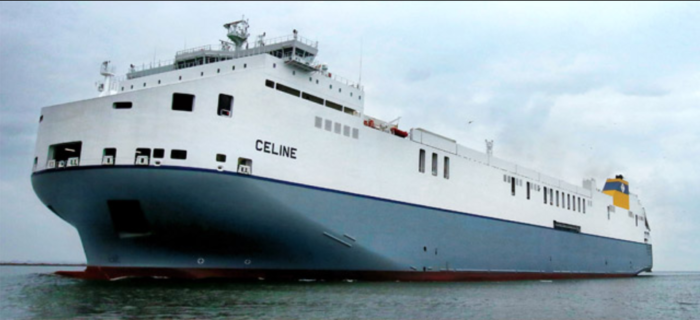In the past, the Luxembourg-based company CLdN Ro-Ro, decided to build the world’s biggest short-sea ro-ro vessels. Celine, after one year of operating, has fully met her owner’s expectations. The former, along with sister-vessel Delphine, incorporate high technology from other vessel types and are LNG-ready.
Mainly, Gary Walker, Director of CLdN addressed that since operating in the North Sea, large vessels decrease the unit price; the company is covering longer distances and larger vessels operate better on long hauls.
[smlsubform prepend=”GET THE SAFETY4SEA IN YOUR INBOX!” showname=false emailtxt=”” emailholder=”Enter your email address” showsubmit=true submittxt=”Submit” jsthanks=false thankyou=”Thank you for subscribing to our mailing list”]
Also, CLdN have expanded their route network from Zeebrugge, Rotterdam, London and Killingholme, into Sweden, Ireland, Denmark, Portugal, and now Santander in Spain.
Celine and Delphine, at 74.000 gross tonnes are 235 metres in length and offer a capacity of 8,000 lane-metres. Walker continued stating that the company had to tailor the vessels fit according to their surroundings. Yet, because of the advanced design and technology, both vessels are easy-to-manoeuvre.
He adds that because of the high-tech, the engine room staff had to adapt to operating two stroke engines than four stroke units, which is the usual amount for the rest of the fleet.
In addition, challenges were also faced by electrical engineers as they had to move from low to medium voltage and operate shaft generators at variable rotational speeds with frequency converters, rather than constant-speed engines.
There were changes in operations as well, with larger volumes and more decks demanding more complex loading and unloading procedures, and better coordination and efficiency in port.
Despite the challenges Walker quoted that
We are almost one year in with Celine, and she is exactly what we hoped she would be.
Both vessels also reflect the company’s first LNG-ready ships, meaning that they are ready to convert to LNG when the time is right.
DNV GL is guiding the company using its Gas Ready Notation.
Bas Veerman, BeNeLux Business Development Manager for Maritime at DNV GL reported that the minimum level confirms that the vessel complies with rules for LNG-fuelled ship design and the main engine can be converted to gas or dual-fuel operation, or is dual-fuel ready. Optional levels may indicate different preparations of the ship for later conversion, such as certification and installation of parts of the LNG fuel system.
Walker states that
Using LNG as fuel is becoming more and more realistic … We are using very-low-sulphur fuel for the present, but the target fuel is LNG.
Concluding, the next CLdN vessels are 217 metres in length with 5,400 lane-metres, ostensibly representing fewer challenges than their big sisters.




























































